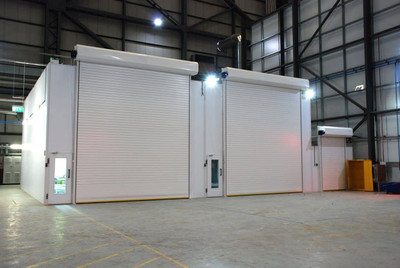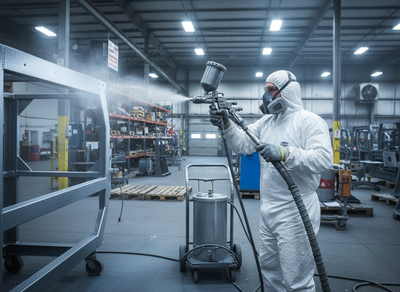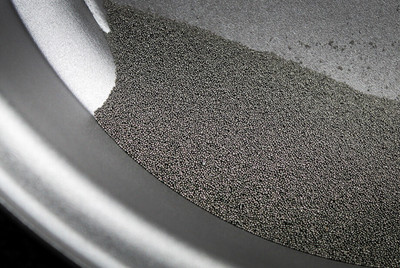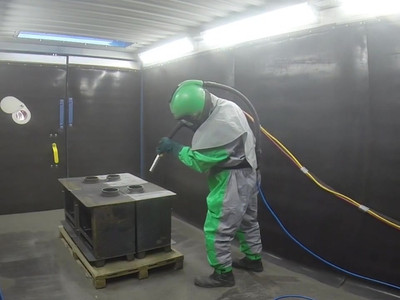8th Oct 2025
When it comes to achieving high-quality paint finishes, your choice of environment matters just as much as your technique and tools. While both spray booths and open workshops have their place, the right choice can significantly affect quality, safety, and efficiency.
Whether you're a skilled sprayer or managing a busy workshop, this comparison outlines the strengths and limitations of each setup – and highlights why a purpose-built spray booth is often the best investment for long-term finish quality and control.
What is a spray booth?
A spray booth is a controlled environment specifically designed for applying paint, coatings, or finishes. It typically features:
- Ventilation and filtration systems.
- Enclosed walls or partitions.
- Lighting optimised for visibility and accuracy.
- Temperature and humidity control (in more advanced models).
The purpose is to contain overspray, manage airflow, reduce contamination, and protect both the operator and the product – all of which contribute to a cleaner, more consistent finish.
What is an open workshop spray area?
An open spray area refers to any unsheltered or non-contained space used for paint application – often without proper ventilation, airflow control, or overhead cover. Spraying in such environments might take place in a corner of a workshop, a warehouse floor, or even outdoors. These setups offer no protection from dust, debris, temperature shifts, or airborne contamination. Without barriers or filtration, overspray can drift freely, affecting nearby surfaces and creating inconsistent results. While this approach may be convenient or cost-saving in the short term, it comes with significant trade-offs in finish quality, safety, and environmental control.
Spray booth vs open workshop: How do they compare?
Here’s a breakdown of the key differences between the two, with a focus on how they affect finish quality.
Finish quality
- Spray booth: A major advantage of a spray booth is its ability to maintain consistent, clean conditions. Reduced dust and airborne debris mean fewer surface flaws and less rework. With optimised lighting and controlled airflow, you’re more likely to achieve a high-quality, uniform finish.
- Open workshop: Open spaces offer no protection from dust, temperature swings, or airflow inconsistencies, which can lead to surface defects like fisheyes, orange peel, runs, or patchy coverage.
Overspray control
- Spray booth: Built-in extraction systems efficiently remove overspray, helping to maintain air quality, reduce mess, and prevent contamination of other work areas.
- Open workshop: Without adequate containment, overspray can drift onto tools, other jobs, or even previously finished surfaces – leading to costly rework and cleanup.
Safety and compliance
- Spray booth: Purpose-built booths are generally designed to meet health and safety regulations, often featuring fire suppression, ventilation systems, and compliant filtration.
- Open workshop: Spraying in open areas can increase health and fire risks, particularly when using flammable materials or inadequate ventilation. These setups may also fall short of HSE standards, especially in commercial settings. For more information on solvent spraying hazards, visit the HSE website.
Flexibility and cost
- Spray booth: While spray booths require upfront investment and dedicated space, they pay off in the long run by improving quality, reducing rework, and boosting efficiency.
- Open workshop: This setup is more cost-effective and adaptable for occasional use or tight spaces. However, the trade-off is a complete lack of environmental control, inconsistent results, and greater safety risks.
Which spray setup is right for you?
Ultimately, the right solution depends on the type of work you do, your production volume, and your expectations for finish quality.
- Choose a spray booth if your priority is delivering a high standard of finish, operating efficiently, and meeting health and safety regulations. The controlled environment of a spray booth reduces the risk of contamination, ensures better airflow and extraction, and supports consistent, repeatable results – even under demanding production schedules. It also helps meet environmental and safety compliance, which is increasingly important for many clients and contracts.
- An open workshop may seem like a more flexible or cost-effective option, especially in smaller operations. But without environmental control, there’s a higher risk of surface defects, overspray issues, and inconsistent results. This can lead to increased rework, wasted materials, and potential compliance concerns – all of which add up over time.
For many businesses, especially those producing customer-facing work or operating in regulated environments, a spray booth isn’t just a smart upgrade – it’s an essential tool.
Final thoughts
Both setups have their place. But if finish quality is critical – and especially if you're working in a professional or commercial capacity – a controlled spraying environment like a spray booth offers clear, long-term benefits.
At Airblast Eurospray, we offer a full range of spray booths, spray rooms, and containerised solutions – all designed to deliver clean, consistent results every time. Whether you need a compact setup or a custom-built unit, our expert team is here to help with knowledgeable advice and exceptional customer service.
Explore our spray booth range today – and take the next step toward better finishing results.




